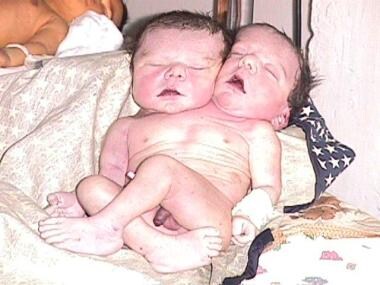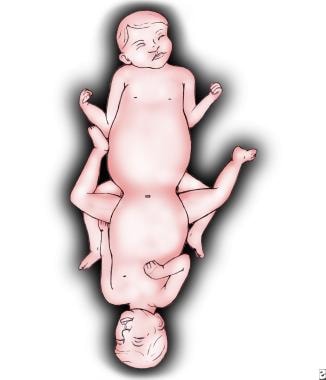History and Physical Examination
Cephalothoracopagus twinning is characterized by the anterior union of the upper half of the body, with two faces angulated variably on a conjoined head. The anomaly is occasionally known as janiceps, named after the two-faced Roman god Janus. The prognosis is extremely poor because surgical separation is not an option, in that only a single brain and a single heart are present and the gastrointestinal (GI) tracts are fused. This malformation is extremely rare (see the image below).
Craniopagus occurs in 2% of conjoined twins. In this variety, the twins have cranial fusion (see the images below). Stone and Goodrich subclassified craniopagus into four varieties, depending on whether a significantly shared dural venous sinus system (total vs partial) is present and on whether the intertwin longitudinal angulation is below 140º. [25]
Bicephalus or dicephalus means that two heads are present on a single trunk (see the images below).
 This set of conjoined twins was a stillbirth. Prenatal ultrasonography failed to reveal the second head. An emergent cesarean section was performed after failure to progress.
This set of conjoined twins was a stillbirth. Prenatal ultrasonography failed to reveal the second head. An emergent cesarean section was performed after failure to progress.
In omphalopagus, the anterior abdomens are united (see the image below). Omphalopagus (34%) is considered a subset of thoracoomphalopagus. Its incidence is usually added to that of thoracopagus (40%) to yield the overall incidence of thoracoomphalopagus (74%). Pure omphalopagus twins have no cardiac union.
A case of thoracoomphalopagus twins, after separation, is shown below.
In the condition parapagus, (see the image below) or diprosopus, [26] twins have lateral union of their trunks so that both faces are forward looking in the same plane.
Pygopagus (see the image below) is the term used when the twins face in opposite directions. The sacra are fused, and the twins may share a portion of the spinal cord. In addition, the rectum and perineal structures are usually fused.
In rachipagus (see the image below), the twins are joined back-to-back at any point, usually above the lumbar spine. They may have extensive vertebral fusion in the dorsal midline and may have meningocele, neural connection, or both. One of the embryos generally fails to survive, leaving some body part attached to the other twin's dorsal column. In these cases, rachipagus must be differentiated from fetus in feto (within a body cavity) and teratoma (no mature organ). [27]
Thoracopagus is the most common variety, occurring in 40% of conjoined twins. The chests are joined, and the hearts are almost always fused in some way (see the images below). As noted above, thoracopagus is often combined with omphalopagus.
 A superior radiographic view of the same set of twins as shown in the previous 2 images. The twins have 2 hearts that are not conjoined, making this a possible operation.
A superior radiographic view of the same set of twins as shown in the previous 2 images. The twins have 2 hearts that are not conjoined, making this a possible operation.
In ischiopagus twins (see the image below), the lower abdomen and the pelves are fused. [28, 29] The twins may have three legs (ie, tripus) or four (ie, tetrapus). The genitourinary system and the rectum are shared; the liver may also be fused.
-
This set of conjoined twins was a stillbirth. Prenatal ultrasonography failed to reveal the second head. An emergent cesarean section was performed after failure to progress.
-
This is an example of double-headed (bicephalus) conjoined twins, a rare occurrence.
-
Even though conjoined twinning is more common in female fetuses (75% of cases), most stillborn conjoined twins are male. A single penis and 2 testes were present in this case.
-
This is a much more rare occurrence termed heteropagus twinning. One twin is not fully formed (parasitic twin) and is dependent on the well-formed one. A malformed head, upper limb, and large ears are present in the parasitic twin. Three legs (tripus) are present.
-
Ethical issues arose in this set. The parents refused separation on the basis that the nonviable twin was still breathing. The wishes of the parents were respected. This set of twins was lost to follow-up.
-
Conjoined twins unified at the thorax and abdomen.
-
Another view of the same set of twins as shown in the previous image.
-
A superior radiographic view of the same set of twins as shown in the previous 2 images. The twins have 2 hearts that are not conjoined, making this a possible operation.
-
Esophagram showing union at the level of stomach.
-
Ischiopagus tetrapus twins.
-
Ischiopagus tripus twins.
-
Thoracoomphalopagus twins.
-
Pygopagus twins.
-
Ischiopagus tetrapus twins.
-
Craniopagus twins.
-
Craniopagus twins.
-
Rachipagus twins.
-
Parapagus twins.
-
Pygopagus twins.
-
Cephalothoracopagus twins.
-
Ischiopagus tetrapus twins.
-
Omphalopagus twins.
-
Thoracopagus twins.
-
Parasitic twinning.
-
Union in a transverse plane in the lower body area, so that the twins face each other.
-
Union in a transverse plane in the lower body area, so that the twins face each other.
-
The term conjoined twinning refers to an incomplete splitting of monozygotic twins after 12 days of embryogenesis. Image created by Samantha Cloutier and Aaron Cloutier.
-
An example of parasitic twin, in which the head is not visible.
-
A nonoperated case of parasitic twins, presenting late.
-
The parasitic twin (sacrificed) after separation.
-
Multiple limbs attached to the thorax.
-
Omphalopagus twins.
-
Omphalopagus twins.
-
Craniopagus twins.
-
A radiograph of the skull, showing the conjoined heads in the case in previous two images.
-
An MRI or CT may show the brain structure, while a magnetic resonance angiography can show the extent of vascular connections.
-
A case of thoracoomphalopagus twins, after separation.
-
Thoracoomphalopagus twins.



















